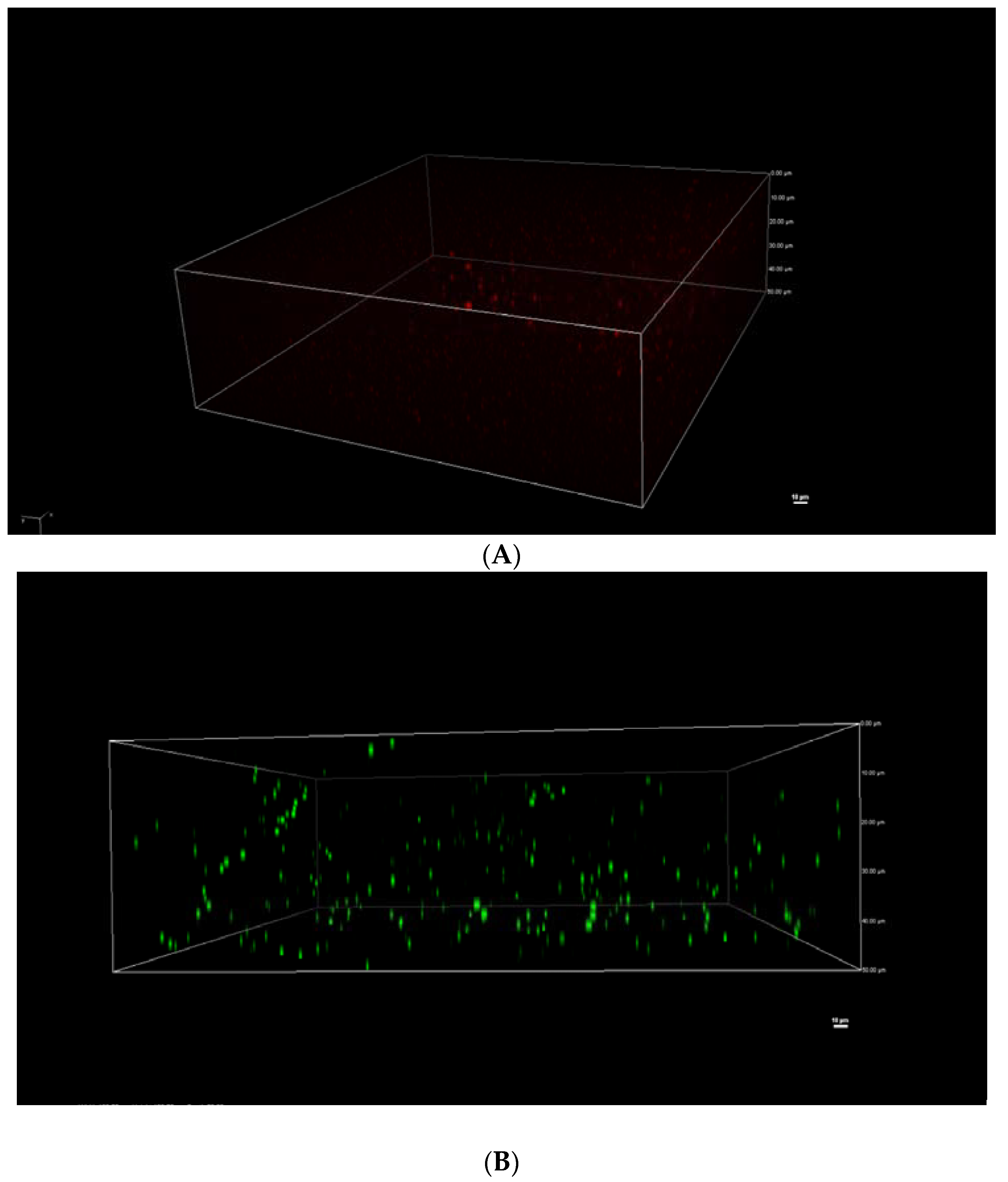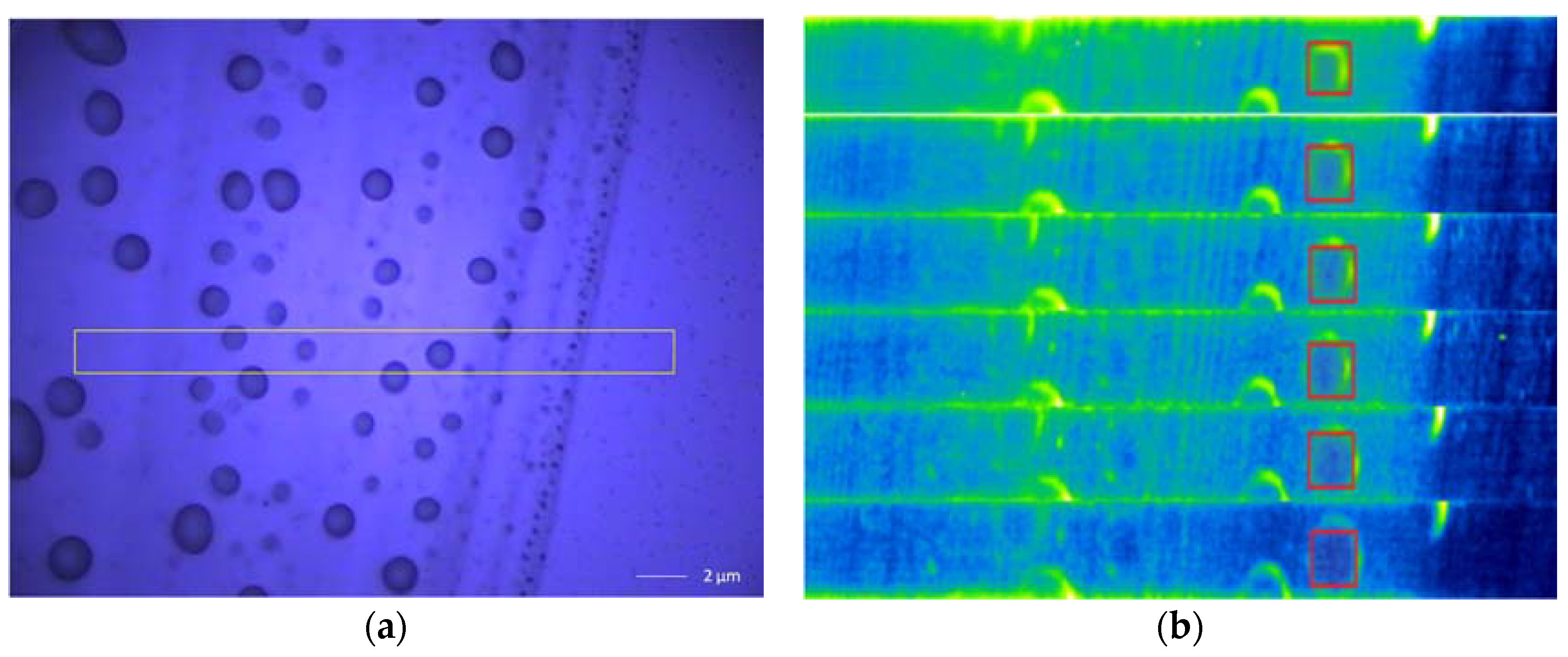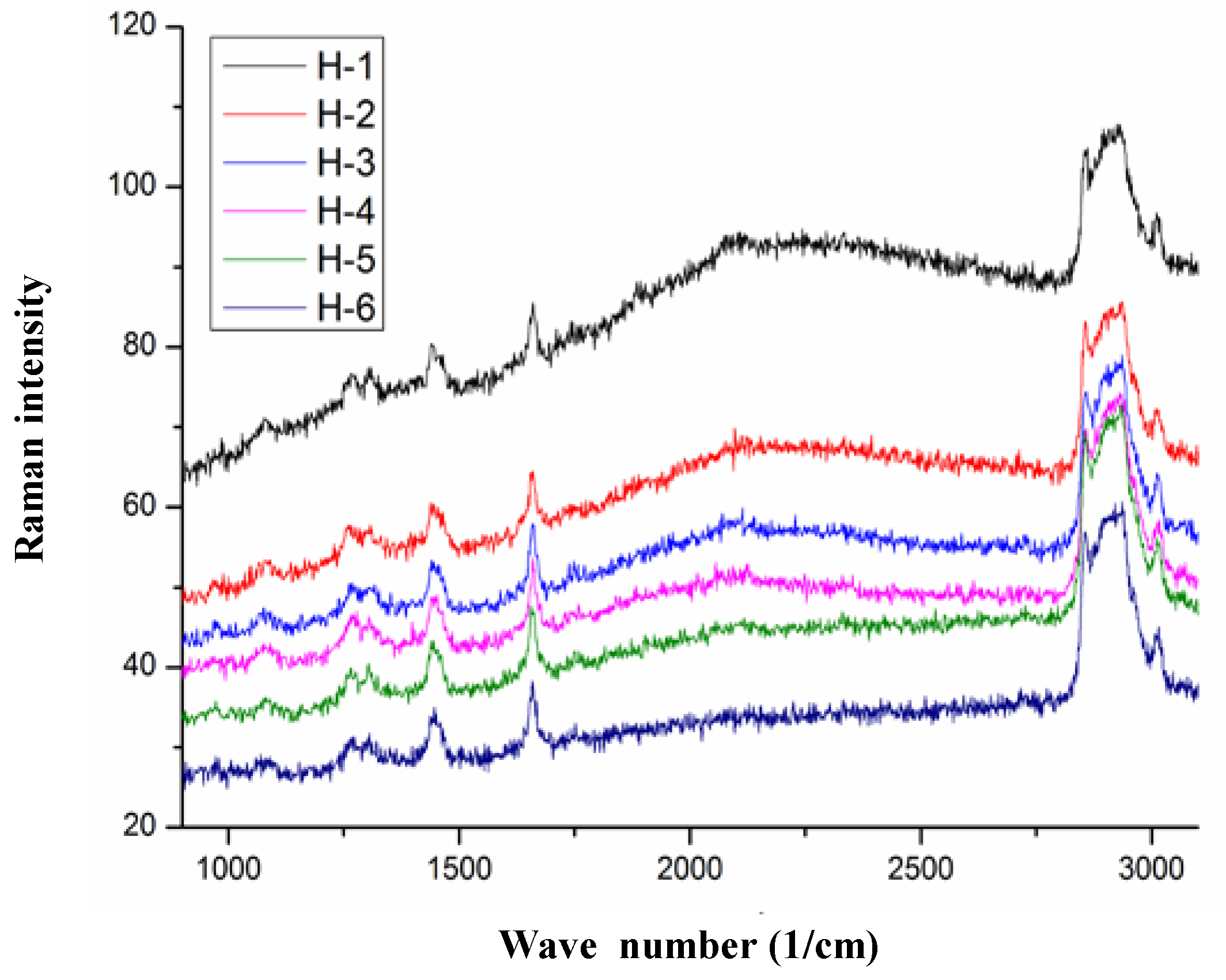Soy Protein Isolate-Phosphatidylcholine Nanoemulsions Prepared Using High-Pressure Homogenization
Abstract
:1. Introduction
2. Materials and Methods
2.1. Experimental Materials
2.2. Preparation of Nanoemulsions
2.3. Measurement of Nanoemulsion Particle Size, Polydispersity Index (PDI) and ζ- Potential
2.4. Measurement of Turbidity
2.5. Turbiscan Stability Index
2.6. Emulsificaton Yield
2.7. Nanoemulsions Morphology by Confocal Laser Scanning Microscopy
2.8. 3D Raman Imaging of Nanoemulsions Morphology
2.9. Statistical Analysis
3. Results and Discussion
3.1. Effect of SPI Addition
3.2. Effect of PC Addition
3.3. Effect of Homogenization Pressure
3.4. Effect of Homogenization Cycles
3.5. Confocal Microscopy Imaging
3.6. 3D Raman Imaging
4. Conclusions
Author Contributions
Funding
Acknowledgments
Conflicts of Interest
References
- Xu, J.; Mukherjee, D.; Chang, S.K.C. Physicochemical properties and storage stability of soybean protein nanoemulsions prepared by ultra-high pressure homogenization. Food Chem. 2017, 240, 1005–1013. [Google Scholar] [CrossRef] [PubMed]
- Oca-Ávalos, J.M.; Candal, R.J.; Herrera, M.L. Nanoemulsions: Stability and physical properties. Curr. Opin. Food Sci. 2017, 16, 1–6. [Google Scholar] [CrossRef]
- Pradhan, N.; Singh, S.; Ojha, N.; Shrivastava, A.; Barla, A.; Rai, V.; Bose, S. Facets of nanotechnology as seen in food processing, packaging, and preservation industry. BioMed Res. Int. 2015, 3–4, 365–672. [Google Scholar] [CrossRef] [PubMed]
- Ricaurte, L.; Perea-Flores, M.D.J.; Martinez, A.; Quintanilla-Carvajal, M.X. Production of high-oleic palm oil nanoemulsions by high-shear homogenization (microfluidization). Innov. Food Sci. Emerg. Technol. 2016, 35, 75–85. [Google Scholar] [CrossRef]
- Komaiko, J.; McClements, D.J. Low-energy formation of edible nanoemulsions by spontaneous emulsification: Factors influencing particle size. J. Food Eng. 2015, 146, 122–128. [Google Scholar] [CrossRef]
- Molina, E.; Papadopoulou, A.; Ledward, D.A. Emulsifying properties of high pressure treated soy protein isolate and 7S and 11S globulins. Food Hydrocoll. 2001, 15, 263–269. [Google Scholar] [CrossRef]
- Tan, C.P.; Nakajima, M. Effect of polyglycerol esters of fatty acids on physicochemical properties and stability of b-carotene nanodispersions prepared by emulsification/evaporation method. J. Sci. Food Agric. 2005, 85, 121–126. [Google Scholar] [CrossRef]
- Yerramilli, M.; Longmore, N.; Ghosh, S. Improved stabilization of nanoemulsions by partial replacement of sodium caseinate with pea protein isolate. Food Hydrocoll. 2017, 64, 99–111. [Google Scholar] [CrossRef]
- Hirotsuka, M.; Taniguchi, H.; Narita, H.; Kito, M. Increase in emulsification activity of soy lecithin-soy protein complex by ethanol and heat treatments. J. Food Sci. 1984, 49, 1105–1110. [Google Scholar] [CrossRef]
- Henry, J.V.L.; Fryer, P.J.; Frith, W.J.; Norton, I.T. The influence of phospholipids and food proteins on the size and stability of model sub-micron emulsions. Food Hydrocoll. 2010, 24, 66–71. [Google Scholar] [CrossRef]
- Van der Meeren, P.; El-Bakry, M.; Neirynck, N.; Noppe, P. Influence of hydrolysed lecithin addition on protein adsorption and heat stability of a sterilised coffee cream simulant. Int. Dairy J. 2005, 15, 1235–1243. [Google Scholar]
- Euston, S.R.; Finnigan, S.R.; Hirst, R.L. Aggregation kinetics of heated whey protein-stabilised emulsions: Effect of low-molecular weight emulsifiers. Food Hydrocoll. 2001, 15, 253–262. [Google Scholar] [CrossRef]
- Kasinos, M.; Goni, M.L.; Nguyen, M.T.; Sabatino, P.; Martins, J.C.; Dewettinck, K.; Van Der Meeren, P. Effect of hydrolysed sunflower lecithin on the heat-induced coagulation of recombined concentrated milk emulsions. Int. Dairy J. 2014, 38, 187–194. [Google Scholar] [CrossRef]
- Sui, X.; Li, Q.; Wang, Z.; Qi, B.; Zou, X.; Li, Y.; Jiang, L. Does the hydrophobic group on sn-2 position of phosphatidylcholine decide its emulsifying ability? Food Sci. Technol. 2016, 74, 255–262. [Google Scholar] [CrossRef]
- Sui, X.; Bi, S.; Qi, B.; Wang, Z.; Zhang, M.; Li, Y.; Jiang, L. Impact of ultrasonic treatment on an emulsion system stabilized with soybean protein isolate and lecithin: Its emulsifying property and emulsion stability. Food Hydrocoll. 2017, 63, 727–734. [Google Scholar] [CrossRef]
- Niu, H.; Xia, X.; Wang, C.; Kong, B.; Liu, Q. Thermal stability and gel quality of myofibrillar protein as affected by soy protein isolates subjected to an acidic pH and mild heating. Int. J. Biol. Macromol. 2018, 242, 188–195. [Google Scholar] [CrossRef] [PubMed]
- Salvia-Trujillo, L.; Rojas-Graü, A.; Soliva-Fortuny, R.; Martín-Belloso, O. Physicochemical characterization and antimicrobial activity of food-grade emulsions and nanoemulsions incorporating essential oils. Food Hydrocoll. 2015, 43, 547–556. [Google Scholar] [CrossRef]
- Jiang, L.; Wang, J.; Li, Y.; Wang, Z.; Liang, J.; Wang, R.; Hen, Y.; Ma, W.; Qi, B.; Zhang, M. Effects of ultrasound on the structure and physical properties of black bean protein isolates. Food Res. Int. 2014, 62, 595–601. [Google Scholar] [CrossRef]
- Rahn-Chique, K.; Puertas, A.M.; Romero-Cano, M.S.; Rojas, C.; Urbina-Villalba, G. Nanoemulsion stability: Experimental evaluation of the flocculation rate from turbidity measurements. Adv. Colloid Interface Sci. 2012, 178, 1–20. [Google Scholar] [CrossRef] [PubMed]
- Luo, M.; Qi, X.; Ren, T.; Huang, Y.; Keller, A.A.; Wang, H.; Wu, B.; Jin, H.; Li, F. Heteroaggregation of CO2, and TiO2, Engineered Nanoparticles in the Aqueous Phase: Application of Turbiscan Stability Index and Fluorescence Excitation-Emission Matrix (EEM) Spectra. Colloids Surf. Physicochem. Eng. Asp. 2017, 533, 9–19. [Google Scholar] [CrossRef]
- Yu, T.; Ni, Z.; Du, C.; Wang, Y.; Shen, Z. Raman mapping investigation of graphene on transparent flexible substrate: The strain effect. J. Phys. Chem. 2008, 112, 12602–12605. [Google Scholar] [CrossRef]
- Hebishy, E.; Buffa, M.; Guamis, B.; Blasco-Moreno, A.; Trujillo, A.J. Physical and oxidative stability of whey protein oil-in-water emulsions produced by conventional and ultra high-pressure homogenization: Effects of pressure and protein concentration on emulsion characteristics. Innov. Food Sci. Emerg. Technol. 2015, 32, 79–90. [Google Scholar] [CrossRef]
- Li, M.; Ma, Y.; Cui, J. Whey-protein-stabilized nanoemulsions as a potential delivery system for water-insoluble curcumin. Food Sci. Technol. 2014, 59, 49–58. [Google Scholar] [CrossRef]
- Yang, F.; Liu, X.; Ren, X.; Huang, Y.; Huang, C.; Zhang, K. Swirling cavitation improves the emulsifying properties of commercial soy protein isolate. Ultrason. Sonochem. 2018, 42, 471–481. [Google Scholar] [CrossRef] [PubMed]
- Song, X.; Zhou, C.; Fu, F.; Chen, Z.; Wu, Q. Effect of high-pressure homogenization on particle size and film properties of soy protein isolate. Ind. Crops Prod. 2013, 43, 538–544. [Google Scholar] [CrossRef]
- Berton, C.; Genot, C.; Ropers, M.H. Quantification of unadsorbed protein and surfactant emulsifiers in oil-in-water emulsions. J. Colloid Interface Sci. 2011, 354, 739–748. [Google Scholar] [CrossRef] [PubMed]
- Berton-Carabin, C.C.; Ropers, M.H.; Genot, C. Lipid oxidation in oil-in-water emulsions: Involvement of the interfacial layer. Compr. Rev. Food Sci. Food Saf. 2014, 13, 945–977. [Google Scholar] [CrossRef]
- Sun, C.; Wu, T.; Liu, R.; Liang, B.; Tian, Z.; Zhang, E.; Zhang, M. Effects of superfine grinding and microparticulation on the surface hydrophobicity of whey protein concentrate and its relation to emulsions stability. Food Hydrocoll. 2015, 51, 512–518. [Google Scholar] [CrossRef]
- Wang, B.; Li, D.; Wang, L.J. Ozkan, N. Effect of concentrated flaxseed protein on the stability and rheological properties of soybean oil-in-water emulsions. J. Food Eng. 2010, 96, 555–561. [Google Scholar] [CrossRef]
- Martínez, K.D.; Ganesan, V.; Pilosof, A.M.R.; Harte, F.M. Effect of dynamic high-pressure treatment on the interfacial and foaming properties of soy protein isolate-hydroxypropylmethylcelluloses systems. Food Hydrocoll. 2011, 25, 1640–1645. [Google Scholar]
- Li, J.; Li, Y.; Guo, S. The binding mechanism of lecithin to soybean 11S and 7S globulins using fluorescence spectroscopy. Food Sci. Biotechnol. 2014, 23, 1785–1791. [Google Scholar] [CrossRef]
- García-Moreno, P.J.; Horn, A.F.; Jacobsen, C. Influence of caseinephospholipid combinations as emulsifier on the physical and oxidative stability of fish oil-in-water emulsions. J. Agric. Food Chem. 2014, 62, 1142–1152. [Google Scholar] [CrossRef] [PubMed]
- Nik, A.M.; Wright, A.J.; Corredig, M. Impact of interfacial composition on emulsion digestion and rate of lipid hydrolysis using different in vitro digestion models. Colloids Surf. Biointerfaces 2011, 83, 321–330. [Google Scholar] [CrossRef] [PubMed]
- Molina, E.; Defaye, A.B.; Ledward, D.A. Soy protein pressure-induced gels. Food Hydrocoll. 2002, 16, 625–632. [Google Scholar] [CrossRef]
- Floury, J.; Desrumaux, A.; Lardieres, J. Effect of high-pressure homogenization on droplet size distributions and rheological properties of model oil-in-water emulsions. Innov. Food Sci. Emerg. Technol. 2000, 1, 127–134. [Google Scholar] [CrossRef]
- Floury, J.; Desrumaux, A.; Legrand, J. Effect of ultra-high-pressure homogenization on structure and on rheological properties of soy proteinstabilized emulsions. J. Food Sci. 2002, 67, 3388–3395. [Google Scholar] [CrossRef]
- Galooyak, S.S.; Dabir, B. Three-factor response surface optimization of nano-emulsion formation using a microfluidizer. J. Food Sci. Technol. 2015, 52, 2558–2571. [Google Scholar] [CrossRef] [PubMed]
- Jafari, S.M.; He, Y.; Bhandari, B. Effectiveness of encapsulating biopolymers to produce sub-micron emulsions by high energy emulsification techniques. Food Res. Int. 2007, 40, 862–873. [Google Scholar] [CrossRef]
- Jafari, S.M.; He, Y.; Bhandari, B. Optimization of nano-emulsions production by microfluidization. Eur. Food Res. Technol. 2007, 225, 733–741. [Google Scholar] [CrossRef]
- Kwan, A.; Davidov-Pardo, G. Controlled release of flavor oil nanoemulsions encapsulated in filled soluble hydrogels. Food Chem. 2017, 250, 46–53. [Google Scholar] [CrossRef] [PubMed]
- Smitthipong, W.; Gadiou, R.; Vidal, L.; Wagner, P.; Nardin, M. 3D Raman images of rubber blends (IR-HNBR). Vib. Spectrosc. 2008, 46, 8–13. [Google Scholar] [CrossRef]



| SPI (%) | Particle Size (nm) | PDI | Zeta Potential (mV) | Emulsificat on Yield (%) | Turbidity | TSI |
|---|---|---|---|---|---|---|
| 0.5 | 735 ± 7 a | 0.42 ± 0.03 a | −8.85 ± 0.08 d | 80.53 ± 0.80 d | 27,000 ± 300 f | 5.33 ± 0.05 a |
| 1.0 | 726 ± 7 a | 0.38 ± 0.02 b | −12.73 ± 0.12 c | 88.82 ± 0.80 b | 28,200 ± 300 e | 4.12 ± 0.04 c |
| 1.5 | 222 ± 2 e | 0.26 ± 0.01 e | −33.61 ± 0.33 a | 91.25 ± 0.90 a | 29,100 ± 300 d | 3.03 ± 0.02 f |
| 2.0 | 395 ± 4 d | 0.29 ± 0.00 d | −33.42 ± 0.33 a | 90.47 ± 0.90 a | 29,900 ± 300 c | 3.26 ± 0.03 e |
| 2.5 | 468 ± 5 c | 0.29 ± 0.04 d | −26.81 ± 0.26 b | 87.24 ± 0.80 c | 34,800 ± 300 b | 3.88 ± 0.03 d |
| 3.0 | 626 ± 6 b | 0.31 ± 0.05 c | −15.95 ± 0.15 c | 80.79 ± 0.80 d | 37,400 ± 300 a | 4.34 ± 0.04 b |
| Phosphatidylch Oline Addition (%) | Particle Size (nm) | PDI | Zeta Potential (mV) | Emulsification Yield (%) | Turbidity | TSI |
|---|---|---|---|---|---|---|
| 0.10 | 433 ± 4 a | 0.43 ± 0.05 a | −12.62 ± 0.12 d | 84.72 ± 0.84 e | 27,300 ± 300 d | 5.14 ± 0.05 a |
| 0.17 | 324 ± 3 b | 0.27 ± 0.01 c | −31.03 ± 0.31 c | 89.21 ± 0.89 c, d | 28,700 ± 300 c | 4.41 ± 0.04 c |
| 0.20 | 222 ± 2 c | 0.26 ± 0.02 d | −33.61 ± 0.33 b | 91.24 ± 0.91 b | 29,200 ± 300 a | 3.45 ± 0.03 e |
| 0.22 | 210 ± 2 d | 0.27 ± 0.01 c | −34.75 ± 0.34 a | 92.95 ± 0.92 a | 29,000 ± 300 b | 4.32 ± 0.04 d |
| 0.25 | 212 ± 2 d | 0.29 ± 0.00 b | −34.86 ± 0.34 a | 90.12 ± 0.90 c | 29,400 ± 300 a | 4.76 ± 0.04 b |
| Homogenization Pressure (MPa) | Particle Size (nm) | PDI | Zeta Potential (mV) | Emulsification Yield (%) | Turbidity | TSI |
|---|---|---|---|---|---|---|
| 60 | 433 ± 4 a | 0.43 ± 0.02 a | −18.62 ± 0.18 d | 63.21 ± 0.63 d | 36,600 ± 400 b | 5.72 ± 0.05 a |
| 80 | 312 ± 3 c | 0.37 ± 0.00 b | −31.24 ± 0.31 b | 85.63 ± 0.85 b | 30,800 ± 300 c | 4.94 ± 0.04 b |
| 100 | 205 ± 2 e | 0.20 ± 0.00 d | −31.36 ± 0.31 b | 92.57 ± 0.92 a | 29,800 ± 300 d | 3.66 ± 0.03 d |
| 120 | 222 ± 2 d | 0.26 ± 0.00 c | −33.62 ± 0.33 a | 91.24 ± 0.90 a | 29,300 ± 300 e | 3.41 ± 0.03 e |
| 140 | 385 ± 3 b | 0.45 ± 0.01 a | −20.89 ± 0.20 c | 82.83 ± 0.82 c | 40,500 ± 400 a | 4.78 ± 0.04 c |
| Number of Homogenizing Cycles | Particle Size (nm) | PDI | Zeta Potential (mV) | Emulsification Yield (%) | Turbidity | TSI |
|---|---|---|---|---|---|---|
| 2 | 291 ± 2 b | 0.21 ± 0.01 c | −28.23 ± 0.22 c | 83.22 ± 0.24 e | 29,700 ± 200 b | 4.62 ± 0.04 c |
| 3 | 295 ± 2 a | 0.23 ± 0.01 b | −30.84 ± 0.23 b | 88.81 ± 0.66 c | 29,900 ± 200 b | 3.43 ± 0.03 e |
| 4 | 222 ± 2 c | 0.26 ± 0.02 a | −33.66 ± 0.33 a | 91.20 ± 0.91 a | 29,300 ± 200 c | 4.24 ± 0.04 d |
| 5 | 210 ± 2 d | 0.25 ± 0.03 a | −33.98 ± 0.31 a | 90.81 ± 0.34 b | 29,100 ± 100 c | 4.75 ± 0.04 b |
| 6 | 225 ± 2 c | 0.27 ± 0.01 a | −31.21 ± 0.21 b | 87.52 ± 0.77 d | 30,600 ± 300 a | 5.12 ± 0.05 a |
© 2018 by the authors. Licensee MDPI, Basel, Switzerland. This article is an open access article distributed under the terms and conditions of the Creative Commons Attribution (CC BY) license (http://creativecommons.org/licenses/by/4.0/).
Share and Cite
Li, Y.; Wu, C.-L.; Liu, J.; Zhu, Y.; Zhang, X.-Y.; Jiang, L.-Z.; Qi, B.-K.; Zhang, X.-N.; Wang, Z.-J.; Teng, F. Soy Protein Isolate-Phosphatidylcholine Nanoemulsions Prepared Using High-Pressure Homogenization. Nanomaterials 2018, 8, 307. https://doi.org/10.3390/nano8050307
Li Y, Wu C-L, Liu J, Zhu Y, Zhang X-Y, Jiang L-Z, Qi B-K, Zhang X-N, Wang Z-J, Teng F. Soy Protein Isolate-Phosphatidylcholine Nanoemulsions Prepared Using High-Pressure Homogenization. Nanomaterials. 2018; 8(5):307. https://doi.org/10.3390/nano8050307
Chicago/Turabian StyleLi, Yang, Chang-Ling Wu, Jun Liu, Ying Zhu, Xiao-Yuan Zhang, Lian-Zhou Jiang, Bao-Kun Qi, Xiao-Nan Zhang, Zhong-Jiang Wang, and Fei Teng. 2018. "Soy Protein Isolate-Phosphatidylcholine Nanoemulsions Prepared Using High-Pressure Homogenization" Nanomaterials 8, no. 5: 307. https://doi.org/10.3390/nano8050307





